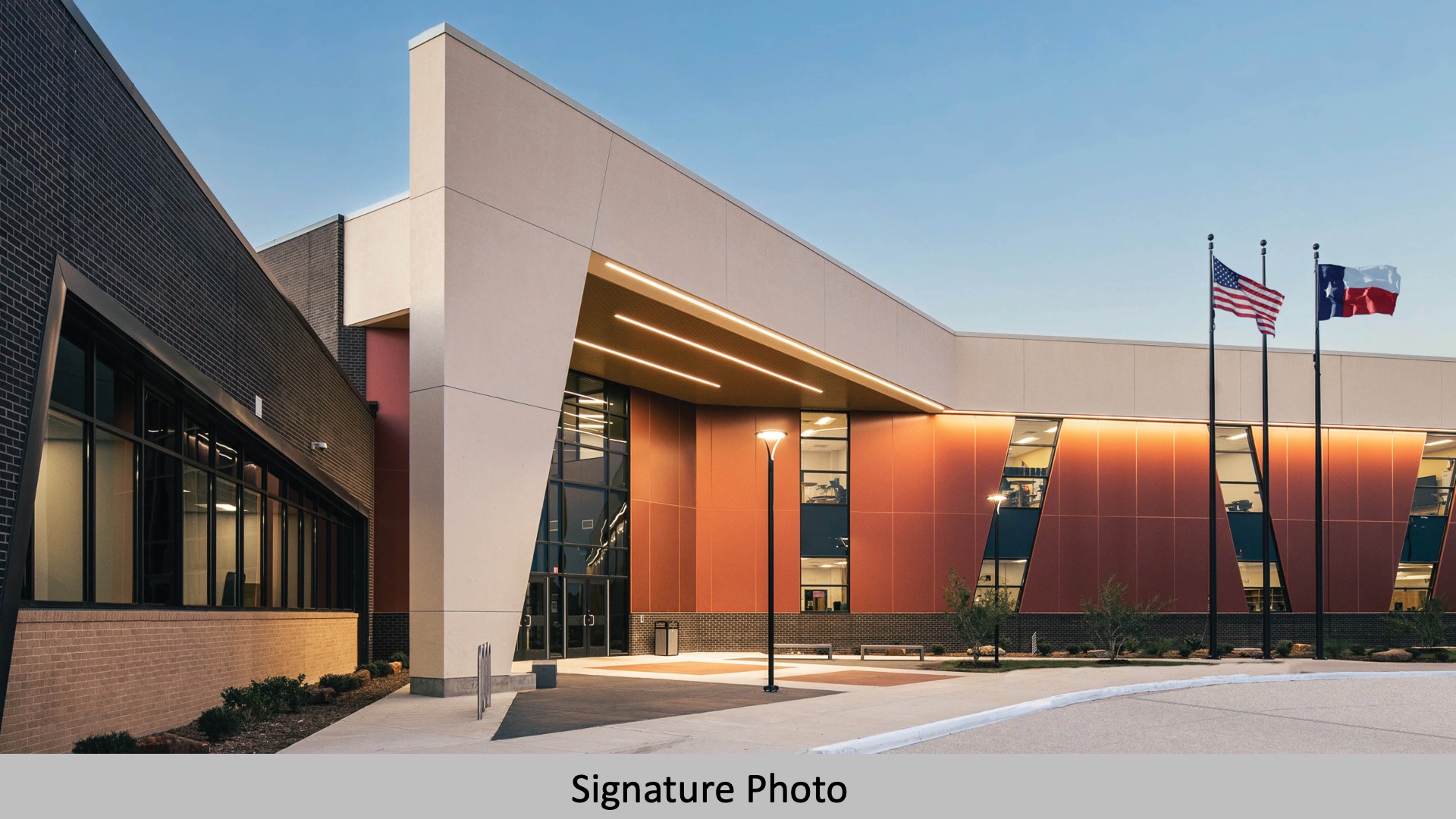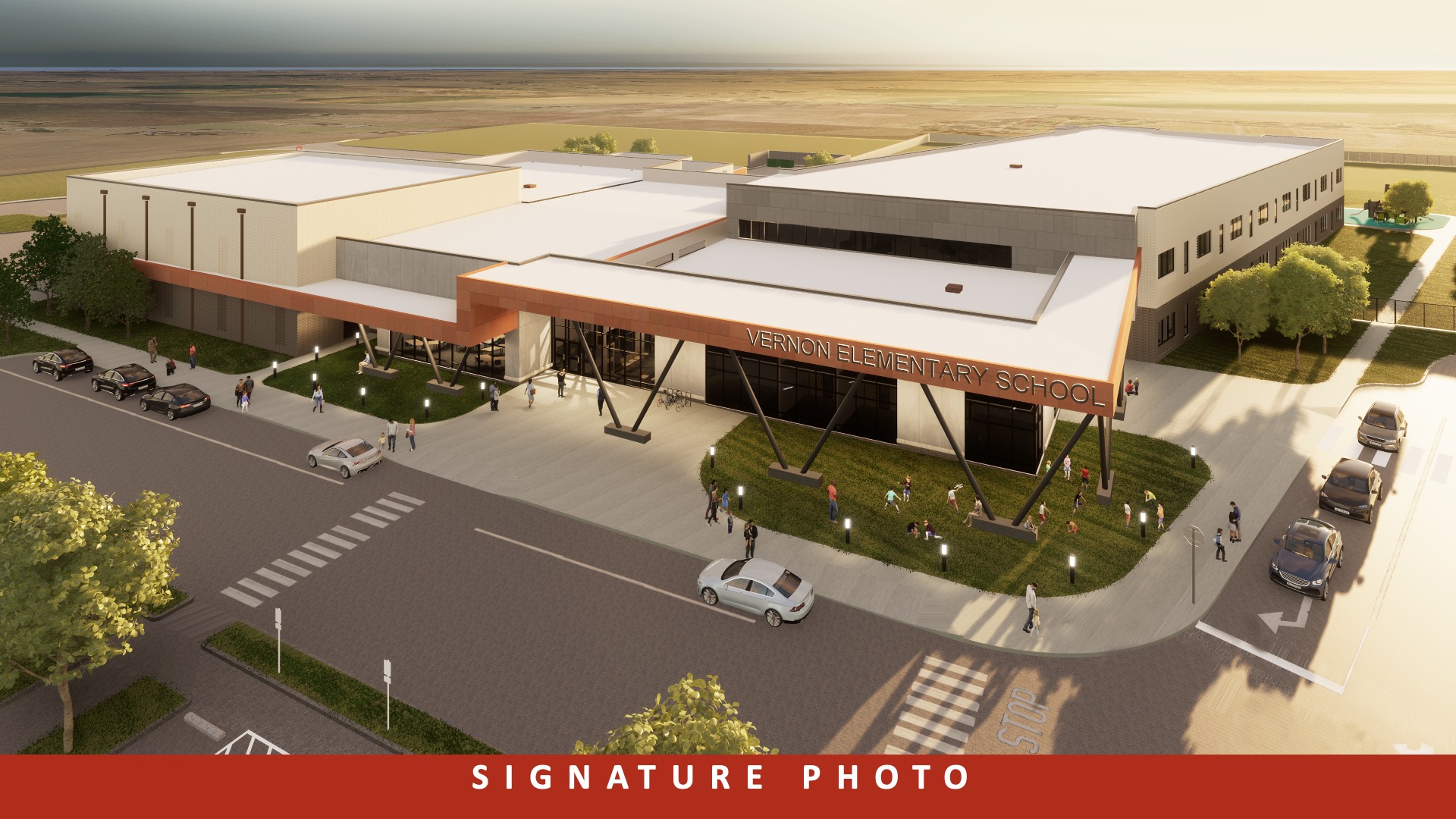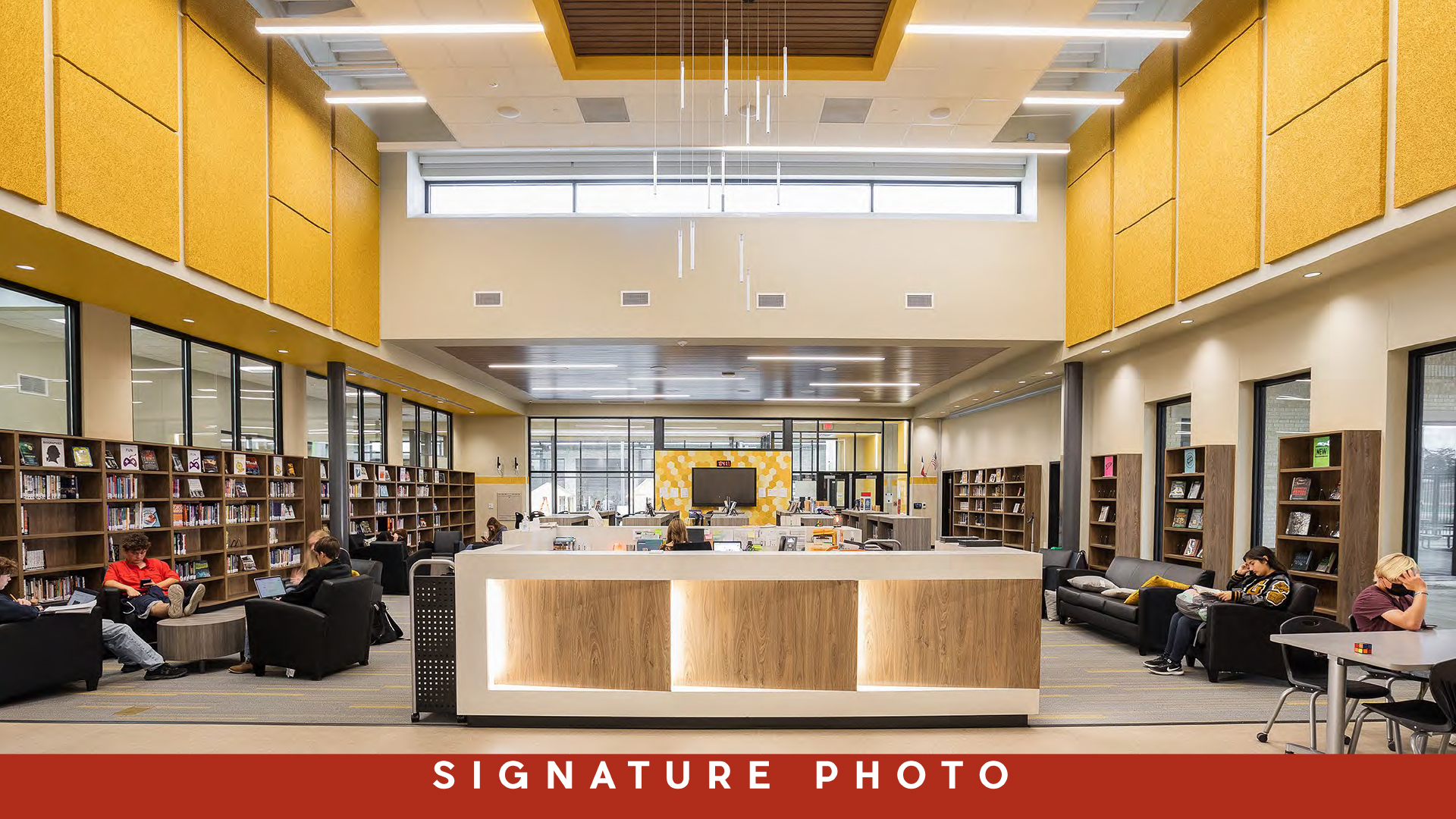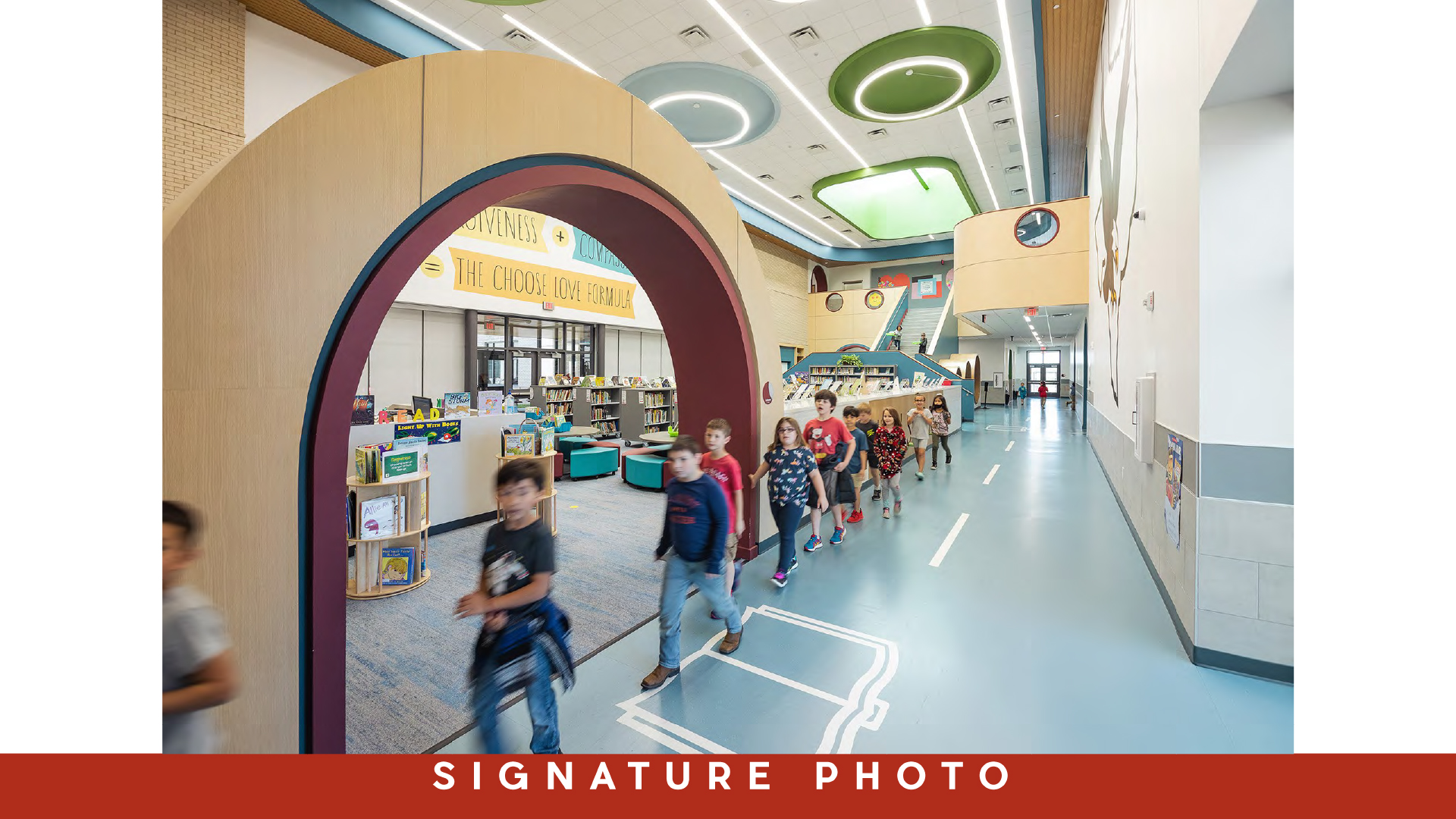When you choose an architect, get to know the professionals you will be working with. By the time you make your decision, you may have found several firms with the experience and problem solving skills to qualify them to design your building. But then ask yourself, do they listen well? Do they have a good imagination? Do they communicate clearly and effectively, both visually and verbally? At WRA we employ people who have these skills AND are a pleasure to work with. We think that matters.
Anna ISD—Clemons Creek Middle School  Located within a fast-growing district, this 157,870 SF, two-story middle school sits on a 22-acre site and includes classrooms, STEM rooms, science labs, art labs, practice and competition gyms, a band hall, and a choir room, both with individual practice rooms. The site also includes a football field, a 4-lane track, field sports, bleachers with a capacity to seat 520 spectators, a digital scoreboard, and a Located within a fast-growing district, this 157,870 SF, two-story middle school sits on a 22-acre site and includes classrooms, STEM rooms, science labs, art labs, practice and competition gyms, a band hall, and a choir room, both with individual practice rooms. The site also includes a football field, a 4-lane track, field sports, bleachers with a capacity to seat 520 spectators, a digital scoreboard, and a |
Anna ISD—Coyote Stadium Renovation  Total renovation of stadium for growing rural community. New Press Box with elevator and open-air covered video deck. Press Box has separate viewing rooms for Home and Visitor coaches, timer/announcer, radio/press, and two spectator rooms for dignitaries and event hosting. Concessions was enlarged. New field events components; additional parking (artificial field turf, and track are recent and remain). Stadium lighting has web-based control and mobile app; coaches control/monitor stadium lights. Total renovation of stadium for growing rural community. New Press Box with elevator and open-air covered video deck. Press Box has separate viewing rooms for Home and Visitor coaches, timer/announcer, radio/press, and two spectator rooms for dignitaries and event hosting. Concessions was enlarged. New field events components; additional parking (artificial field turf, and track are recent and remain). Stadium lighting has web-based control and mobile app; coaches control/monitor stadium lights. |
|
Anna ISD—Rosamond-Sherley Elementary School  As a fast-growth district serving over 5,100 students, Anna ISD needed an elementary school design that it could easily replicate on new sites while not sacrificing collaborative spaces and innovation. This 85,000 square foot prototype was designed to capture as much natural light as possible for its 800 students and was set back from the highway with a gradual ingress to the campus. To enhance safety & security, the play areas are sheltered in between the facility’s two wings and there is one. As a fast-growth district serving over 5,100 students, Anna ISD needed an elementary school design that it could easily replicate on new sites while not sacrificing collaborative spaces and innovation. This 85,000 square foot prototype was designed to capture as much natural light as possible for its 800 students and was set back from the highway with a gradual ingress to the campus. To enhance safety & security, the play areas are sheltered in between the facility’s two wings and there is one. |
Blue Ridge ISD—Blue Ridge Elementary School  Many hours in public workshops planning this school led to a theme of “Education as a Journey.” Students are led on this journey by a continuous colorful ribbon running throughout the school, ending at a “launch pad” in the Cafetorium where they enjoy a beautiful view of their future Middle School. Exceptional views are featured on all sides of the building. The new building has ample space for Collaboration, break-out sessions, learning stairs, outdoor learning areas, and small gathering pods. Many hours in public workshops planning this school led to a theme of “Education as a Journey.” Students are led on this journey by a continuous colorful ribbon running throughout the school, ending at a “launch pad” in the Cafetorium where they enjoy a beautiful view of their future Middle School. Exceptional views are featured on all sides of the building. The new building has ample space for Collaboration, break-out sessions, learning stairs, outdoor learning areas, and small gathering pods. |
|
Brock ISD—Brock Elementary School  An all-new 21st Century school designed to facilitate this District’s Next Generation learning. Initially grades PK–2, expanding in future to PK-4. Secure glass-enclosed Reception area overlooks the main entrance and entrances to the Gymnasium and Cafeteria. Cafeteria opens to the Library, main corridor, outdoor courtyard, and playground. Classrooms in each grade area are grouped around open Collaboration spaces, instead of corridors, to facilitate multiple activities and varied learning styles. An all-new 21st Century school designed to facilitate this District’s Next Generation learning. Initially grades PK–2, expanding in future to PK-4. Secure glass-enclosed Reception area overlooks the main entrance and entrances to the Gymnasium and Cafeteria. Cafeteria opens to the Library, main corridor, outdoor courtyard, and playground. Classrooms in each grade area are grouped around open Collaboration spaces, instead of corridors, to facilitate multiple activities and varied learning styles. |
Castleberry ISD—Gary S. Jones Administration Building  The building, a 1938 WPA project in the Art Deco style, expanded in 1945, bears a Texas Historic Commission marker. After serving as an elementary school for 75 years, a replacement school was constructed next door and this building became the District’s Administration Building. Preserving the historical character of this early 20th Century building was a goal in this renovation. The old Cafeteria/Auditorium became the new Board Room and the entire building was updated to modern standards. The building, a 1938 WPA project in the Art Deco style, expanded in 1945, bears a Texas Historic Commission marker. After serving as an elementary school for 75 years, a replacement school was constructed next door and this building became the District’s Administration Building. Preserving the historical character of this early 20th Century building was a goal in this renovation. The old Cafeteria/Auditorium became the new Board Room and the entire building was updated to modern standards. |
|
Community ISD—Roderick Elementary School  The district is fast-growth and wanted a prototype elementary school design it could use for future sites in the district. However, it didn’t want just any “off-the- shelf” design. They requested an 84,300 square foot school that promoted collaboration and exuded the values it wanted to impart to its 750 students: to be generous, passionate, humble, and wise. You see them as soon as you enter the school & all throughout your visit. The design has been successfully replicated multiple times. The district is fast-growth and wanted a prototype elementary school design it could use for future sites in the district. However, it didn’t want just any “off-the- shelf” design. They requested an 84,300 square foot school that promoted collaboration and exuded the values it wanted to impart to its 750 students: to be generous, passionate, humble, and wise. You see them as soon as you enter the school & all throughout your visit. The design has been successfully replicated multiple times. |
Crandall ISD—Crandall High School Expansion  A 43,000 SF classroom addition increasing the school’s total capacity from 900 to 1,350 students and a 3,000 SF cafetorium expansion with a new outdoor plaza and pre-function gathering space increasing the Performing Arts facilities. This expansion facilitates Next Generation learning with collaboration areas, large overhead glass doors, enhanced technology, flexible space, and flexible furniture. CTE facilities include Culinary Arts, Interior Design, and Medical Science spaces. A 43,000 SF classroom addition increasing the school’s total capacity from 900 to 1,350 students and a 3,000 SF cafetorium expansion with a new outdoor plaza and pre-function gathering space increasing the Performing Arts facilities. This expansion facilitates Next Generation learning with collaboration areas, large overhead glass doors, enhanced technology, flexible space, and flexible furniture. CTE facilities include Culinary Arts, Interior Design, and Medical Science spaces. |
|
Crandall ISD—Crandall Middle School  This 195,000 square foot middle school was designed to empower each student it houses to positively impact the world. The facility was meant to provide the local community with a school that focuses on fine arts and pushed the boundaries of innovation in school design. Natural light plays a prominent role throughout the school and is harnessed to enhance both instructional and support spaces. The school’s locker rooms support student athletes and acts as a storm shelter for the entire campus. This 195,000 square foot middle school was designed to empower each student it houses to positively impact the world. The facility was meant to provide the local community with a school that focuses on fine arts and pushed the boundaries of innovation in school design. Natural light plays a prominent role throughout the school and is harnessed to enhance both instructional and support spaces. The school’s locker rooms support student athletes and acts as a storm shelter for the entire campus. |
Crandall ISD—Hollis T. Dietz Elementary School  A new school on a new site in a fast-growth neighborhood. The project palette employs design elements from the new subdivision including natural stone and standing seam metal roofing. Features include multi-purpose and shared-use areas within the instructional zones. Designed as a 21st Century learning environment, the school also includes many Sustainable Design features making it highly energy-efficient. Every classroom has natural daylight, with skylights used in the interior zone classrooms. A new school on a new site in a fast-growth neighborhood. The project palette employs design elements from the new subdivision including natural stone and standing seam metal roofing. Features include multi-purpose and shared-use areas within the instructional zones. Designed as a 21st Century learning environment, the school also includes many Sustainable Design features making it highly energy-efficient. Every classroom has natural daylight, with skylights used in the interior zone classrooms. |
|
Crandall ISD—Opal Smith Elementary School  Situated in a fast-growing area, the district acknowledged the need for a new elementary school that tied into the middle school and overall community. The 98,00 square foot project features a cafeteria, gymnasium, and media center on the north side of the building, with a 2-story academic wing located on the south side of the site. Situated in a fast-growing area, the district acknowledged the need for a new elementary school that tied into the middle school and overall community. The 98,00 square foot project features a cafeteria, gymnasium, and media center on the north side of the building, with a 2-story academic wing located on the south side of the site. |
Fort Worth ISD—Washington Heights Elementary
A CHPS-Designed on-site replacement school on a tight urban site, one of this original school’s most unusual features is that it was underground because of a nearby airport. Many design challenges helped shape and locate the building on the small 4-acre site. Due to the tight site, the stormwater detention requirement was met using the void from the old school as an underground detention tank. The design solved airport noise and safety of the students and faculty during the construction period. |
|
| Gatesville ISD—Gatesville High School, Renovation and Expansion
This 108-year old school, built in 1914, was renovated throughout and expanded by an additional 55,000 SF. Uniting the historic structure with contemporary amenities, the updated campus now presents a new cohesive face to the neighborhood. Additions include a new Science Wing, CTE Wing, Cafeteria, and a new Library. Renovations include repurposing the existing Library into a new Administration Suite, converting the old Cafeteria into new Classrooms, and renovating and adding new Courtyard areas. |
Hillsboro ISD—Hillsboro Elementary School
Replacing a 40-year-old elementary school, this new campus on a new 45-acre site is designed for up to 1,012 students. The old school is being renovated for new District Administration offices. Academic programs include 5 learning houses for grades Pre-K through 3rd. The project includes specialized classrooms for Science, Art, Music, Computer, and Special Education. Also includes Cafetorium with Stage, Media Center/Library, Outdoor Learning Areas, and the Gymnasium doubles as a Storm Shelter. |
|
| Lancaster ISD—Obama Ninth Grade Center
Major renovation to convert a 30-year old elementary school into a modern learning environment for 21st Century high school freshmen. The makeover provides a stimulating collegiate atmosphere that helps students transition from middle school to high school to college and career. The old Cafetorium was transformed into a new Commons to be a central connector to all major areas of the school. Large glass overhead doors facilitate spontaneous collaboration and more interaction between students. |
Mesquite ISD—Dr. Linda Henrie Elementary
A new CHPS-Designed, Sustainable, 21st Century method school using Geothermal Technology. As the largest of the District’s several dozen elementary schools, stakeholders committed to maximizing the new building’s energy efficiency, both initial and long-term, and equipping the facility and its 1,000 students with provisions for the District’s 21st Century learning methods. Major design features include optimum solar orientation and a variety of flexible learning spaces throughout the school. |
|
| Mesquite ISD—Isaac Newton Range Elementary
A new Sustainable, 21st Century school replaces a 54-year old school on the same site. The old building had outlived its useful life, and total replacement was the most cost-effective long-term solution for accommodating the District’s learning methods and energy goals. The site abuts a City park; District and City worked together to trade sites. The new structure was constructed with school in session and no construction disruption. The old school was then demolished and became a new City park. |
Mesquite ISD—Lanny Frasier Middle School
A new middle school for 1200 students, including an 1800 seat football/track stadium. The two-story classroom building is organized to provide individual core-classroom communities for each of the 3 grades served. Shared spaces include a light-filled Media Commons and adjacent Cafeteria, both fronting on a central Courtyard; rehearsal spaces for Band, Choir, and Orchestra, separate Gymnasiums for competition and practice, and a large locker room building constructed as an EF-5 Tornado Shelter. |
|
| Mesquite ISD—Mesquite High School Addition/Renovation
The site is a registered Historic Landmark. Project goals were to honor the school’s historic character, create Next Generation learning spaces, provide technology-intensive Collaboration Areas and a Technology Bar, upgrade instructional areas to current TEA standards, increase capacity for growth, provide an EF-5 Tornado Shelter, and eliminate portables. The project includes new sky bridges and improved circulation, giving students smoother, secure connections with the rest of the campus. |
Mesquite ISD—Mesquite Memorial Stadium
Total renovation of a 20,000-seat stadium. Major design goals were to modernize its appearance, construct a larger Pressbox to meet Texas 5A-6A requirements, and larger Locker Rooms. Finished project is 18,750 seats with larger Concourse, improved spectator access to Restrooms and Concessions, expanded Concourse-level viewing of the field, expanded Concessions queuing and serving, extensive media technology upgrades, upgraded security and better separation of performing students from spectators. |
|
| Mesquite ISD—Vanguard High School
Envisioned to look more like a high tech office complex than a traditional high school, this project is an all-CTE campus, championed by grassroots voices in education and local industry. Students from all over the District may apply for admission. Disciplines include I.T., Robotics, Logistics, Engineering, Architecture, Construction Science, Medical Science. Unlike the District’s other high schools, this has no extracurricular fine arts or athletics, focusing only on college/career preparation. |
Midland ISD—Ralph Bunche Elementary School
A Sustainable project designed for maximum long-term cost-efficiency and the full complement of the District’s new 21st Century learning features. The project replaces an old school with an all new building that boasts collaborative teaching areas, special-purpose and multi-function spaces, and shared community-use spaces. Each grade level has its own large Collaboration Area adjacent to its classrooms, and large glass walls enable teachers and staff to monitor multiple areas simultaneously. |
|
| Plano ISD—Plano East Senior High School Addition
This signature addition is situated on a highly visible and significant part of this large high school campus. On the last remaining large open space, the school’s iconic “Front Lawn,” the building form was carefully crafted to honor its prominent view and accentuate the large campus lake it faces. Next Generation learning spaces for Math and Engineering with wide views of the lake, several Collaboration Areas, and a shaded Outdoor Learning area. A serrated design allows due-North-facing glass. |
Plano ISD—Plano East Senior High School Health Sciences Academy
Health sciences academy developed by the District with local community college. The facility provides state of the art training in many programs and awards college credit certifications in Health Information Management, Certified Nursing Assistant, Emergency Medical Technician, Medical Examiner, and others. Facility includes computer labs, hospital rooms, EMT apartment, Prosthetics, and Autopsy. Design includes full height glass between classrooms and corridors and multiple collaboration areas. |
|
| Sunnyvale ISD—Sunnyvale Middle School Next Generation
Bright, creative teachers played significant roles developing a vision, the Four C’s – Collaboration, Communication, Creativity, Critical Thinking. Strategies: Ignite students’ enthusiasm; Foster collaboration between students and teachers; Multiple simultaneous learning activities. Workshops produced an uncommon architecture: Multiple spaces, flooded with North light, loosely connected by large garage doors, multiple configurations from small groups to large presentations to combined classes. |
Tyler ISD—Moore Middle School & MST Magnet
A middle school replacement building also housing the District MST Magnet school. The east and west wings of the building are the loud public spaces, creating a large courtyard. 21st Century and Sustainability features include shared-use collaboration spaces on each floor, sheltered outdoor learning spaces in the courtyard, enhanced acoustics in classrooms, windows in every classroom and work area, east-west orientation of the classroom wing minimizing heat load, and an Energy Management System. |
|
| Van Alstyne ISD—Bob and Lola Sanford Elementary School
District’s second elementary a new concept, the product of District-wide collaboration. Major goals were to enhance Next Generation learning, technology access throughout, flexible learning environments, and natural light. Grades PreK-1 are on the ground floor, grades 2-5 upstairs. Includes landscaped courtyard for outdoor learning activities. Classrooms are secured from night activities in Cafetorium, Library, and Gymnasium. Zig-zag corridor walls create break-out spaces adjacent to classrooms. |
Vernon ISD—Vernon Elementary School  The school represents a comprehensive and innovative approach to design, community integration, and sustainability, significantly transforming the educational landscape for grades two through five. This state-of-the-art campus is a source of pride for the community, embodying a strong commitment to educational excellence and long-term sustainability. The project consolidates three previously separate schools into one cohesive 79,500 square foot, two-story site, designed to address both current needs and future growth projections. The school represents a comprehensive and innovative approach to design, community integration, and sustainability, significantly transforming the educational landscape for grades two through five. This state-of-the-art campus is a source of pride for the community, embodying a strong commitment to educational excellence and long-term sustainability. The project consolidates three previously separate schools into one cohesive 79,500 square foot, two-story site, designed to address both current needs and future growth projections. |
















